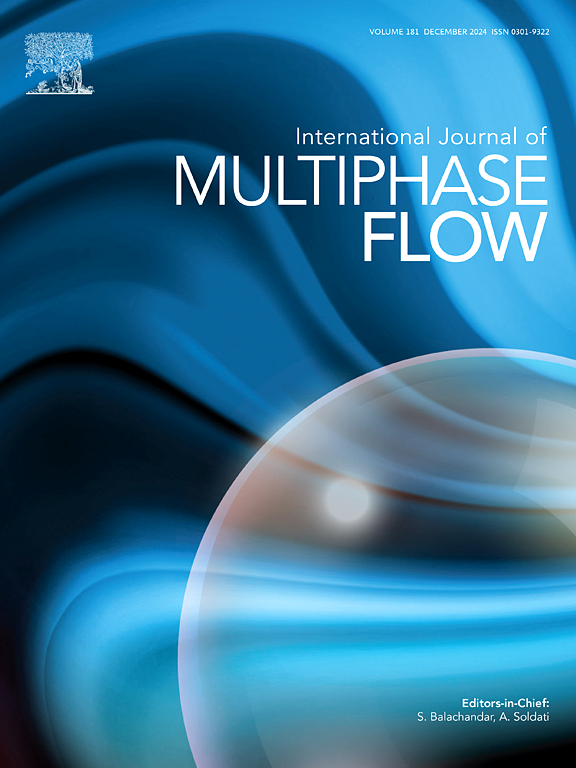水平多相流条件下水合物颗粒团聚与沉积动力学模拟
IF 3.6
2区 工程技术
Q1 MECHANICS
International Journal of Multiphase Flow
Pub Date : 2025-06-08
DOI:10.1016/j.ijmultiphaseflow.2025.105327
引用次数: 0
摘要
天然气水合物因其巨大的全球储量而被认为是未来的重要能源。为探究水合物提取过程中水合物颗粒生长、团聚和沉降对油气输送管道流动保障的影响,本研究采用计算流体力学(CFD)和扩展离散元法(EDEM)建立了水平多相流条件下的三维模型。该模型模拟了管道内不同颗粒体积分数条件下水合物颗粒的生长和分布,以及水合物颗粒在管壁上的附着和沉积。此外,还研究了水平管道中颗粒直径和各种流体成分(油、水和气体)对水合物浆体流动特性的影响。结果表明,水合物层的形成始于颗粒体积分数为20%。当体积分数达到30%时,颗粒壁碰撞频率和压降显著增加。在这一关键阶段防止沉积增强了管道流动的保证。压降的变化与颗粒质量分数相关;聚集引起的体积膨胀逐渐将主导力从粘附力和摩擦力转变为惯性,从而降低了壁面粘附的倾向。在以气体为主的体系中,在0.28 ~ 0.42 m/s的速度范围内存在过渡区,在动态平衡条件下,粒子数量稳定在(2.99±0.16)%。这些初步发现为分析油气管道中水合物颗粒聚集和沉积的相关挑战提供了理论支持。本文章由计算机程序翻译,如有差异,请以英文原文为准。
Modeling agglomeration and deposition kinetics of hydrate particles under horizontal multiphase flow conditions
Natural gas hydrate is considered a critical energy source for the future due to its vast global reserves. To explore the impacts of hydrate particle growth, agglomeration and sedimentation on the flow assurance of oil and gas transportation pipelines during hydrate extraction, this study employs Computational Fluid Dynamics (CFD) and extended discrete element method (EDEM) to develop a three-dimensional model under horizontal multiphase flow conditions. The model simulates hydrate particle growth and distribution, as well as their adhesion and deposition on the pipe wall under varying particle volume fractions within the pipeline. Furthermore, it examines the effects of particle diameter and various fluid compositions (oil, water, and gas) in horizontal pipelines on hydrate slurry flow characteristics. Results indicate that hydrate layer formation begins at a particle volume fraction of 20 %. When the volume fraction reaches to 30 %, the frequency of particle-wall collisions and pressure drop increase significantly. Deposition prevention during this critical phase enhances pipeline flow assurance. Variations in pressure drop correlate with particle mass fractions; agglomeration-induced volume expansion gradually shifts the dominant forces from adhesion and friction to inertia, thereby reducing the propensity for wall adhesion. In gas-dominated systems, transition zones exist within the velocity range of 0.28 to 0.42 m/s, where particle population stabilize at (2.99 ± 0.16) % under dynamic equilibrium conditions. These preliminary findings offer theoretical support for analyzing the challenges associated with hydrate particle agglomeration and deposition in oil and gas pipelines.
求助全文
通过发布文献求助,成功后即可免费获取论文全文。
去求助
来源期刊
CiteScore
7.30
自引率
10.50%
发文量
244
审稿时长
4 months
期刊介绍:
The International Journal of Multiphase Flow publishes analytical, numerical and experimental articles of lasting interest. The scope of the journal includes all aspects of mass, momentum and energy exchange phenomena among different phases such as occur in disperse flows, gas–liquid and liquid–liquid flows, flows in porous media, boiling, granular flows and others.
The journal publishes full papers, brief communications and conference announcements.

 求助内容:
求助内容: 应助结果提醒方式:
应助结果提醒方式:


